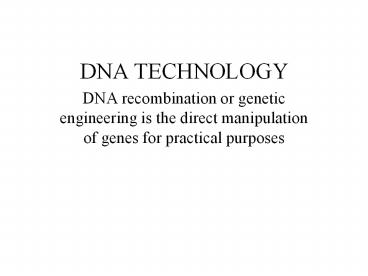DNA TECHNOLOGY - PowerPoint PPT Presentation
1 / 26
Title:
DNA TECHNOLOGY
Description:
DNA TECHNOLOGY DNA recombination or genetic engineering is the direct manipulation of genes for practical purposes Recombinant DNA technology Refers to the set of ... – PowerPoint PPT presentation
Number of Views:204
Avg rating:3.0/5.0
Title: DNA TECHNOLOGY
1
DNA TECHNOLOGY
- DNA recombination or genetic engineering is the
direct manipulation of genes for practical
purposes
2
Recombinant DNA technology
- Refers to the set of techniques for combining
genes from different sources in vitro( in a test
tube) and transfering this DNA into a cell so it
can be expressed. - These techniques were first developed around 1975
and resulted in the appearance of the
Biotechnology industry
3
CONNECTION
0
- 12.7 DNA technology is changing the
pharmaceutical industry - DNA technology
- Is widely used to produce medicines and to
diagnose diseases
4
What is biotechnology?
- The use of living organisms to do practical
tasks. - Examples
- The use of microorganisms to make cheese
and wine - Selective breeding of livestock and crops
- Production of antibiotics from microorganisms
- Production of monoclonal antibodies
5
What is the goal of biotechnology?
- To find practical applications of DNA tecniques
for the improvement of human health and food
production - Examples
- Making gene products using Genetic Engineering
- Uses in basic research
- Medical uses. Diagnosis of disease
- Making vaccines and other pharmaceutical products
- Forensic uses of DNA such as DNA fingerprinting
- Agricultural uses such as manipulatingplant genes
and making transgenic plants.
6
The tools of recombinant DNA
- Plasmids
- Restriction enzymes
- Gel electrophoresis
- PCR ( polymerase chain reaction)
7
BACTERIAL PLASMIDS AND GENE CLONING
0
- 12.1 Plasmids are used to customize bacteria An
overview - Gene cloning is one application of DNA technology
- Methods for studying and manipulating genetic
material
8
- Researchers can insert desired genes into
plasmids, creating recombinant DNA - And insert those plasmids into bacteria
0
Bacterium
Cell containing gene of interest
Plasmid
Bacterial chromosome
DNA
Recombinant DNA (plasmid)
Gene of interest
Recombinant bacterium
Copies of gene
Copies of protein
Clone of cells
Gene for pest resistance inserted into plants
Protein used tomake snow format
highertemperature
Figure 12.1
Gene used to alter bacteria for cleaning up toxic
waste
Protein used to dissolve bloodclots in heart
attack therapy
9
0
- Therapeutic hormones
- In 1982, humulin, human insulin produced by
bacteria - Became the first recombinant drug approved by the
Food and Drug Administration
10
Gene therapy may someday help treat a variety of
diseases
0
- Gene therapy
- Is the alteration of an afflicted individuals
genes
Cloned gene (normal allele)
Viral nucleic acid
Retrovirus
Bone marrow cell from patient
Bone marrow
Figure 12.13
11
0
- 12.11 Restriction fragment length polymorphisms
can be used to detect differences in DNA sequences
12
0
- How Restriction Fragments Reflect DNA Sequence
- Restriction fragment length polymorphisms (RFLPs)
- Reflect differences in the sequences of DNA
samples
Figure 12.11A
13
CONNECTION
0
- 12.9 DNA microarrays test for the expression of
many genes at once - DNA microarray assays
- Can reveal patterns of gene expression in
different kinds of cells
14
- DNA microarray
0
DNA microarray
Each well contains DNA from a particular gene
Actual size (6,400 genes)
Reverse transcriptase and fluorescent
DNA nucleotides
Nonfluorescent spot
Fluorescent spot
cDNA
DNA of an expressed gene
DNA of an unexpressed gene
Figure 12.9
15
0
- 12.10 Gel electrophoresis sorts DNA molecules by
size
16
0
- After digestion by restriction enzymes
- The fragments are run through a gel
17
0
- 12.11 Restriction fragment length polymorphisms
can be used to detect differences in DNA sequences
18
0
- Using DNA Probes to Detect Harmful Alleles
- Radioactive probes
- Can reveal DNA bands of interest on a gel
19
0
- Detecting a harmful allele using restriction
fragment analysis
Figure 12.11C
20
CONNECTION
0
- DNA technology is used in courts of law
21
0
- DNA and Crime Scene Investigations
- Many violent crimes go unsolved
- For lack of enough evidence
- If biological fluids are left at a crime scene
- DNA can be isolated from them
22
0
- DNA fingerprinting is a set of laboratory
procedures - That determines with near certainty whether two
samples of DNA are from the same individual - That has provided a powerful tool for crime scene
investigators
23
DNA Fingerprinting
- 1st-The DNA molecule is cut with restriction
enzymes - 2nd- we have to separate the fragments
- This is done by a technique called gel
electrophoresis - The DNA is placed on a tray filled with gel
through which an electric current runs causing
the fragments to move through the gel. The
segments separate by how far they move in the gel
according to size. - The DNA will form bands corresponding to the
bases (and no two people have the same sequence
of bases) in the gel which are unique for each
individual. This is DNA fingerprinting
24
0
- DNA fingerprinting can help solve crimes
Figure 12.12A
25
Safety and ethical issues
26
- Methods for purifying the DNA
- Vectors for carrying the DNA into cells and
replicating it - Techniques for determining nucleotide sequences
of DNA molecules































